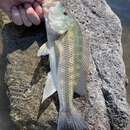Diagnostic Description
provided by Fishbase
Description: more slender than congeners; head large and pointed; mouth large; caudal fin truncate (Ref. 52307).Coloration: head and body olive-green to olive-brown; most body scales with rusty brown to reddish dot at centre; dorsal and caudal fins grayish blue with many reddish maculae or dots; all coloration patterns much weaker in females; males very intensely-colored when courting, possessing yellow throat and breast (Ref. 52307).
Life Cycle
provided by Fishbase
Constructs a sandscrape nest. Incubates eggs in the mouth.
Trophic Strategy
provided by Fishbase
Frequency of occurence in Caprivi: occasionally in sandy streams, occasionally in standing deep water, occasionally in shallow swamps (Ref. 037065).
Biology
provided by Fishbase
Also caught with drawnets. The habitat preferences are strongly influenced by the presence or absence of the tigerfish Hydrocynus forskahlii: if the tigerfish is absent, S. thumbergi is found in open waters and sometimes in fast-flowing rocky habitats; in areas where the tigerfish occurs, S. thumbergi is relegated to lagoons, backwaters and marshy shallow areas. Feeds on small fish, insects and snails (Ref. 6465).
Importance
provided by Fishbase
fisheries: subsistence fisheries; gamefish: yes

